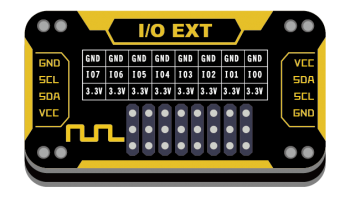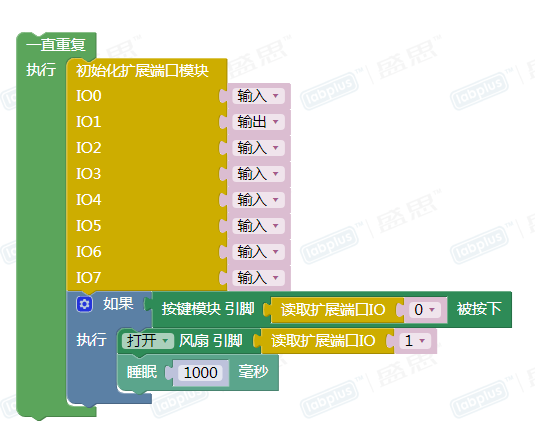“端口扩展”的版本间的差异
来自Labplus盛思维基百科
Labplus课程组(讨论 | 贡献) |
Tangliufeng(讨论 | 贡献) (→MicroPython示例) |
||
| 第29行: | 第29行: | ||
from microbit import * | from microbit import * | ||
| − | def | + | def extIOInit(pin, mode): |
| − | + | i2c.write(0x20, bytearray([3])) | |
| − | + | mode_old=i2c.read(0x20, 1) | |
| + | mode_new = 0 | ||
| + | if mode == 1: | ||
| + | mode_new = mode_old[0] | (1 << pin) | ||
| + | elif mode == 0: | ||
| + | mome_new = mode_old[0] | (~(1 << pin)) | ||
| + | cfg= bytearray([0x03,mode_new]) | ||
| + | i2c.write(0x20, cfg) | ||
| − | def | + | def readExtendedIO(pin): |
| − | + | reg=bytearray([0]) | |
| − | + | i2c.write(0x20, reg) | |
| − | + | dat=i2c.read(0x20, 4) | |
| − | + | return (dat[0] >> pin) & 0x01 | |
| − | def | + | def writeExtendedIO(pin, output): |
| − | + | reg=bytearray([1]) | |
| − | + | i2c.write(0x20, reg) | |
| − | + | stat_old=i2c.read(0x20, 3) | |
| + | stat_new = 0 | ||
| + | if output == 1: | ||
| + | stat_new = stat_old[0] | (1 << pin) | ||
| + | elif output == 0: | ||
| + | stat_new = stat_old[0] & (~(1 << pin)) | ||
| + | cfg = bytearray([0x01, stat_new]) | ||
| + | i2c.write(0x20,cfg) | ||
| + | extIOInit(0,0) #pin io0 set output mode | ||
| + | extIOInit(1,0) #pin io1 set output mode | ||
| + | extIOInit(6,1) #pin io6 set input mode | ||
while True: | while True: | ||
| − | + | buttonVal = readExtendedIO(6) | |
| − | + | if buttonVal == 0: | |
| − | + | writeExtendedIO(0, 1) | |
| − | + | writeExtendedIO(1, 1) | |
| − | + | elif buttonVal == 1: | |
| − | sleep( | + | writeExtendedIO(0, 0) |
| + | writeExtendedIO(1, 0) | ||
| + | sleep(100) | ||
</pre> | </pre> | ||
2018年8月23日 (四) 11:55的版本
概述
当主控的引脚不够用时,可用该模块通过I2C接口拓展I/O口,最大支持8个I/O引脚拓展。
技术参数
- 工作电压:VCC 3.3-5V
- I2C数字信号通讯
- 最大支持8个I/O端口拓展
- 模块尺寸:24x46x7.5mm
引脚定义
| VCC | 电源 |
| SDA | I2C数据 |
| SCL | I2C时钟 |
| GND | 地 |
使用教程
详细的寄存器操作和指令说明,可查阅芯片手册点击下载
MicroPython示例
from microbit import *
def extIOInit(pin, mode):
i2c.write(0x20, bytearray([3]))
mode_old=i2c.read(0x20, 1)
mode_new = 0
if mode == 1:
mode_new = mode_old[0] | (1 << pin)
elif mode == 0:
mome_new = mode_old[0] | (~(1 << pin))
cfg= bytearray([0x03,mode_new])
i2c.write(0x20, cfg)
def readExtendedIO(pin):
reg=bytearray([0])
i2c.write(0x20, reg)
dat=i2c.read(0x20, 4)
return (dat[0] >> pin) & 0x01
def writeExtendedIO(pin, output):
reg=bytearray([1])
i2c.write(0x20, reg)
stat_old=i2c.read(0x20, 3)
stat_new = 0
if output == 1:
stat_new = stat_old[0] | (1 << pin)
elif output == 0:
stat_new = stat_old[0] & (~(1 << pin))
cfg = bytearray([0x01, stat_new])
i2c.write(0x20,cfg)
extIOInit(0,0) #pin io0 set output mode
extIOInit(1,0) #pin io1 set output mode
extIOInit(6,1) #pin io6 set input mode
while True:
buttonVal = readExtendedIO(6)
if buttonVal == 0:
writeExtendedIO(0, 1)
writeExtendedIO(1, 1)
elif buttonVal == 1:
writeExtendedIO(0, 0)
writeExtendedIO(1, 0)
sleep(100)
图形化示例
版本历史记录
| Version | Date | Note [+]新增[-]删除[^]修复 |
|---|---|---|
| V2.0 |

